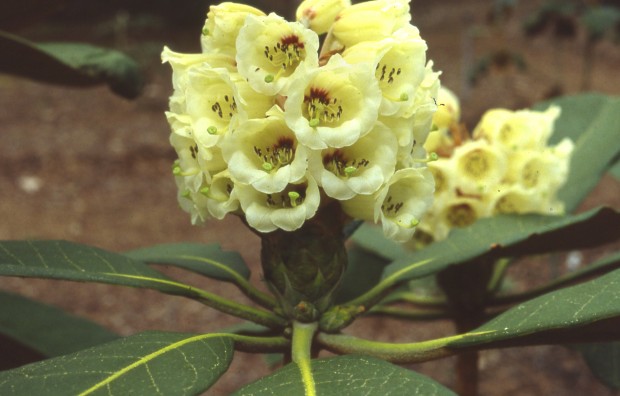
For sheer majesty in the genus Rhododendron, one would be hard-pressed to surpass the big-leafed Himalayan tree R. falconeri. The huge bold leathery leaves up to 14 inches in length are more than matched by the large, rounded inflorescence of white to pale yellow flowers. The stout growth habit and overall massive scale of this species have led some to christen it “one of the dinosaurs of the genus.” The species, as now understood, comprises two subspecies, ssp. falconeri and ssp. eximium (Nuttall) D.F. Chamb. (R. eximium Nuttall).
R. falconeri ssp. falconeri was first brought to the attention of western botanists and gardeners by Joseph Dalton Hooker who described and collected seed of this species during his famous 1948-50 expedition to Sikkim. Although this is generally the accepted first date of introduction into the west, H. H. Davidian notes that a few plants were in gardens in the United Kingdom from seed collected by Colonel Sykes in 1830. I am uncertain if any of these plants still remain alive. There are specimens of this species grown from Hooker’s original introduction of seed still growing in several old collections in the United Kingdom, including one famous plant in the gardens of Glenarn, Scotland.
R. falconeri ssp. eximium was first collected and distributed to western gardens by Thomas Booth who found it in the mountains of Bhutan/Arunachal Pradesh some time around 1850. Like subspecies falconeri, several gardens in the United Kingdom still grow ancient and massive specimens of this taxon which probably originated from this first introduction.
This species is a member of Subsection Falconera and is in fact, the type species for that group. This subsection comprises one half of the “big-leaf” species, the others belonging to Subsection Grandia. Within Subsection Falconera, this species is rated as one of the finest for the garden as it is relatively hardy and extremely attractive.
Both subspecies have been reintroduced on numerous occasions from throughout their respective ranges. Subspecies falconeri is known to occur in the eastern Himalaya from E Nepal through Sikkim and Bhutan, including adjacent areas of NE India (Arunachal Pradesh & West Bengal). It occurs from 9,000 to 12,500 feet in coniferous forests and mixed deciduous/coniferous forest. In some areas, this species is the dominant canopy tree, forming small forests typically up to 40 or 50 feet in height. During my expedition to Sikkim in the spring of 1997, I was able to observe this firsthand. While exploring the mountains near Bersay, we made a short trek to a traveler’s hut on an isolated peak surrounded by forests of R. falconeri. In a sheltered valley nearby, we came upon one of the most spectacular displays of the genus Rhododendron that I have ever had the privilege to witness. I gazed in awe at a small grove of trees fully 80 feet in height. The massive straight trunks were clear of branches for two-thirds of their length with the overlapping canopies high overhead preventing all but the smallest rays of sunlight from reaching the quiet forest floor. As my eyes followed these forest giants in their quest towards the sky, I was taken back to my home in the coniferous forests of the Pacific Northwest.
This subspecies frequently hybridizes with another member of Subsection Falconera (i.e. hodgsonii) and a certain member of Subsection Grandia (i.e. kesangiae). This typically happens where the ranges of the species overlap. The former cross is quite common in the wild as the two species share a similar range and habitat. This natural hybrid has been named R. x decipiens Lacaita.
Subspecies eximium is found to the east of ssp. falconeri in NE India (Arunachal Pradesh) and E Bhutan(?). The two subspecies seem to merge taxonomically and can intergrade considerably in morphological characteristics where the ranges overlap in the extreme eastern portion of the Bhutanese Himalaya and adjacent areas of western Arunachal Pradesh.
Subspecies falconeri typically grows as a tree or forms a massive shrub, often growing wider than high in cultivation. The growth is stout and new shoots are covered with a pale brown indumentum. The bark on the older stems and trunks is an attractive peeling reddish brown. The thick and leathery leaves are elliptic to obovate in shape and usually around a foot in length on a well-grown specimen. They are a rugose matte green on the upper surface with little or no traces of indumentum and prominent yellow veins. The lower surface is densely covered with a stunning brown to red-brown indumentum of cup-shaped hairs. The inflorescence is composed of around 20 flowers up to two inches long arranged in a massive rounded ball. The bell-shaped, eight-lobed flowers are white to cream, pale yellow or pinkish and have a prominent purple blotch. The flowers are often slightly fragrant and their heavy textural substance gives them incredible longevity. They often remain attractive for up to a month before dropping. This subspecies blooms in mid- to late spring and a large specimen covered in flowers is one of the grand sites in the natural world.
Subspecies eximium typically forms a smaller, more shrubby, though still massive-growing plant than its arboreal relative. It often grows into a wide-spreading plant with a flat-topped habit which better displays its magnificent indumented foliage. It has a reddish peeling bark on the older stems. The leaves are oval to obovate-elliptic in shape and covered on the upper surface with a thick and persistent layer of rusty-brown indumentum. This spectacular ornamental feature is unmatched in the genus. The lower surface of the leaves is covered with a deeper cinnamon-brown, woolly indumentum. The fleshy flowers are similar to those of ssp. falconeri but typically in shades of rose or pink, often fading to cream flushed rose after a few days.
In cultivation, both taxa perform best in sheltered gardens with a maritime influence such as New Zealand and the west coasts of Britain and North America. Like all of the “big-leafs,” which are basically plants of the forest, these long-lived plants require protection from damaging winds and the hot afternoon sun. They require ample soil moisture during the growing season to develop properly their massive foliage. Both are relatively hardy, rated to +5 F° by Cox. These may seem like rather exacting conditions for cultivation, but remember, these guidelines are for optimal success. I have seen many well-grown specimens in gardens with less than optimal conditions along the west coasts of Canada and the USA. Plants of both subspecies suffered foliar damage in December of 1990 when the temperature dropped to +4 F° twice during a one-week period.
Subspecies falconerihas been used occasionally in hybridizing programs, usually being crossed with other big-leaf species. One of the most famous of the resulting hybrids is ‘Fortune,’ a clone resulting from a cross made by Rothschild between R. falconeri ssp. falconeri and R. sinogrande which received a First Class Certificate when exhibited in 1938. A clone of the species itself received an Award of Merit when exhibited by the Gill Nursery in 1922.
Subspecies eximium has been rarely if ever used as a parent in hybridizing programs. It received an Award of Merit in 1973 as a foliage plant when exhibited by Royal Botanic Gardens, Wakehurst.
As I have stated in the past, as with all of the “big-leaf” species, many, if not an extremely large percent of the plants in cultivation as this species, are grown from garden origin seed. Unfortunately, most of this seed is open-pollinated and thus the resultant plants are most likely hybrids. Once you have seen the “real” R. falconeri, it is quite easy to distinguish between them. We are now offering beautiful and vigorous seedlings of the “real thing” grown from my own collections in the Sikkim Himalaya. I urge you to try this species, one of the finest in the genus.
ACCESSIONS IN THE COLLECTION OF THE RSF:
Subspecies eximium
77/738 Windsor. I have not recorded flowering data on this clone.
77/785 Stonefield. Deep pink in bud, opening pale pink and fading to cream, with maroon basal blotching.
We have numerous recent accessions from collections made in 1988 by Warren Berg in Bhutan (BB#8816 & BB#8822). These were collected as R. eximium but seem to lie between the two subspecies based on foliage morphology. They have yet to bloom.
Subspecies falconeri
75/124 RBGE. I have not recorded flowering data on this clone.
81/079 Clark:Gambrill. Light yellow flowers.
81/108 Tashi:Smith,Britt. This is a “good foliage and flower, high elevation form” collected by Tse Ten Tashi in Sikkim.
I will be accessioning numerous new clones into the collection from my collections (SEH#’s 517, 519 & 524) in the Sikkim and West Bengal Himalaya.
REFERENCES CONSULTED:
Chamberlain, D.F. 1982. A Revision of Rhododendron. II. Subgenus Hymenanthes. Notes from the Royal Botanic GardenEdinburgh. Edinburgh, Scotland: Her Majesty’s Stationary Office. Vol. 39(2):pgs. 259-260.
Cox, Peter A., and Kenneth N. E. Cox. 1997. The Encyclopedia of Rhododendron Species. Perth, Scotland: Glendoick Press. Pgs. 40-41.
Davidian, H.H. 1989. The Rhododendron Species. Vol. II. Portland, OR: Timber Press. Pgs. 166-169.
Hootman, S.E. 1997. Unpublished field notes.
Rhododendron Species Foundation: Records – 1964 to present.
Steve Hootman
